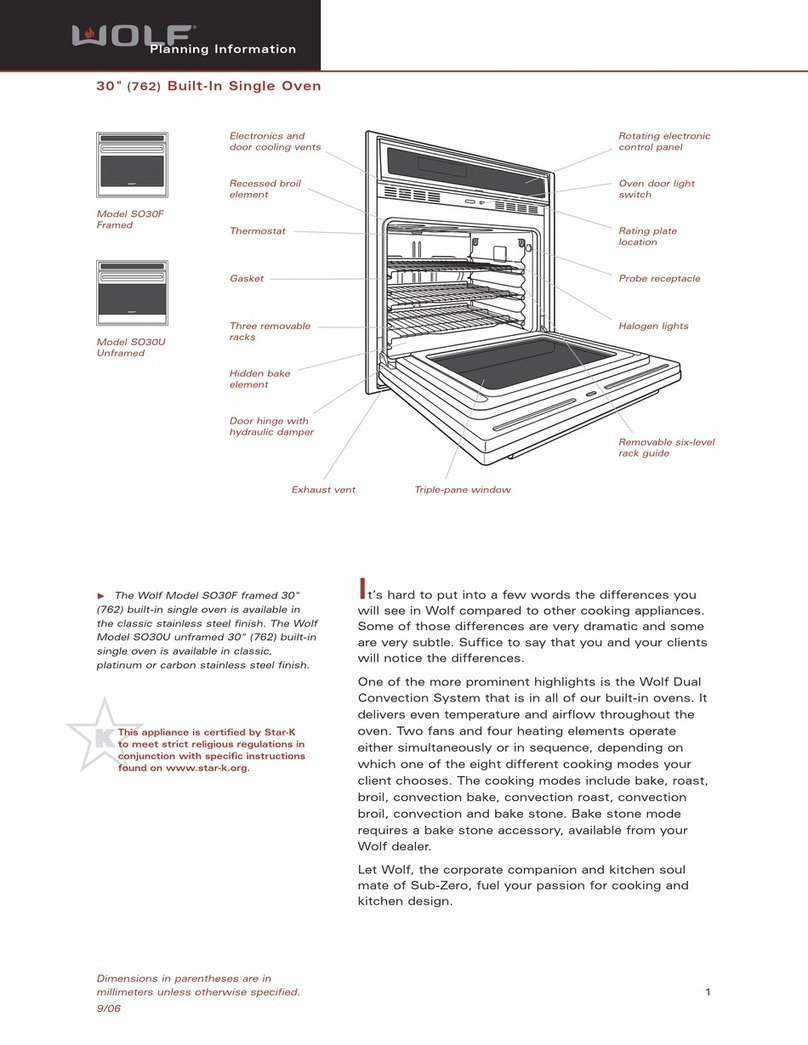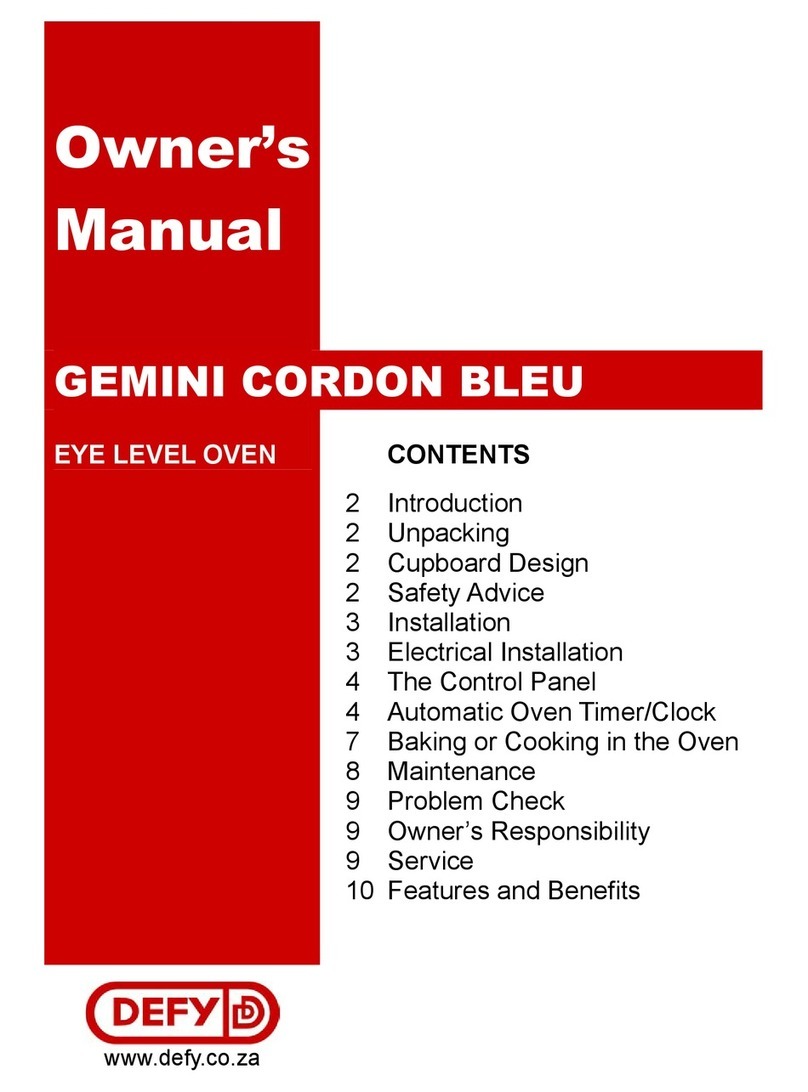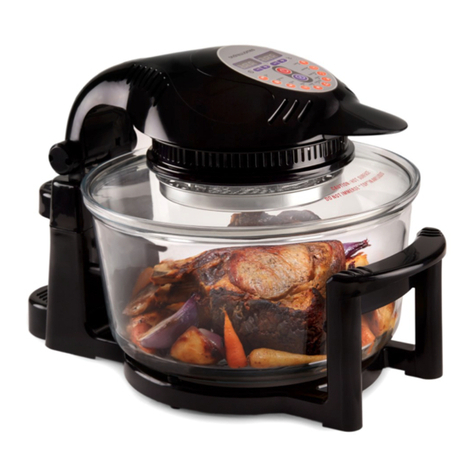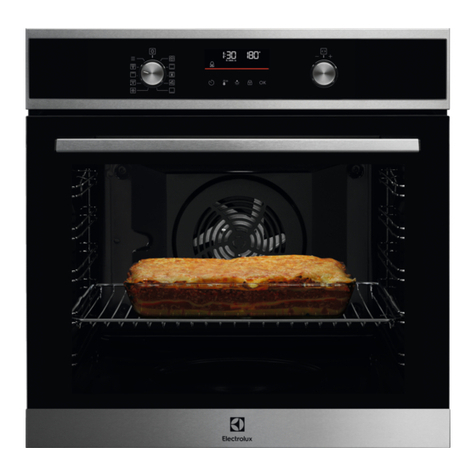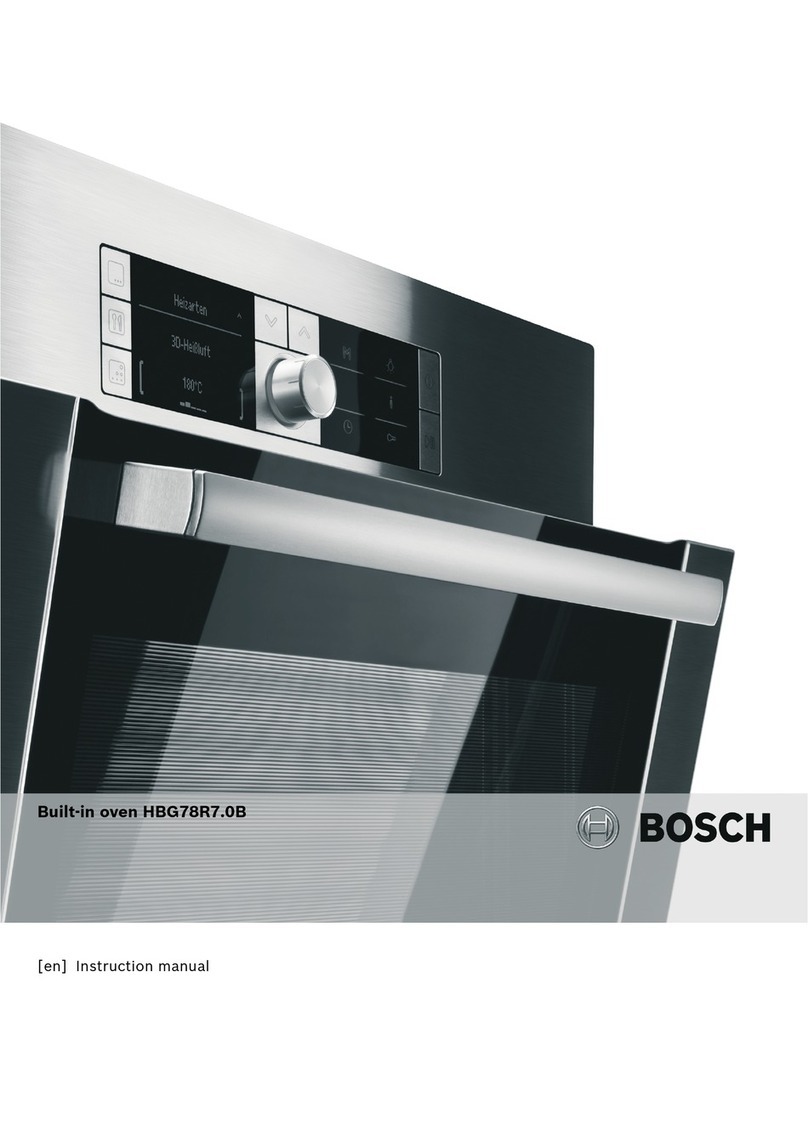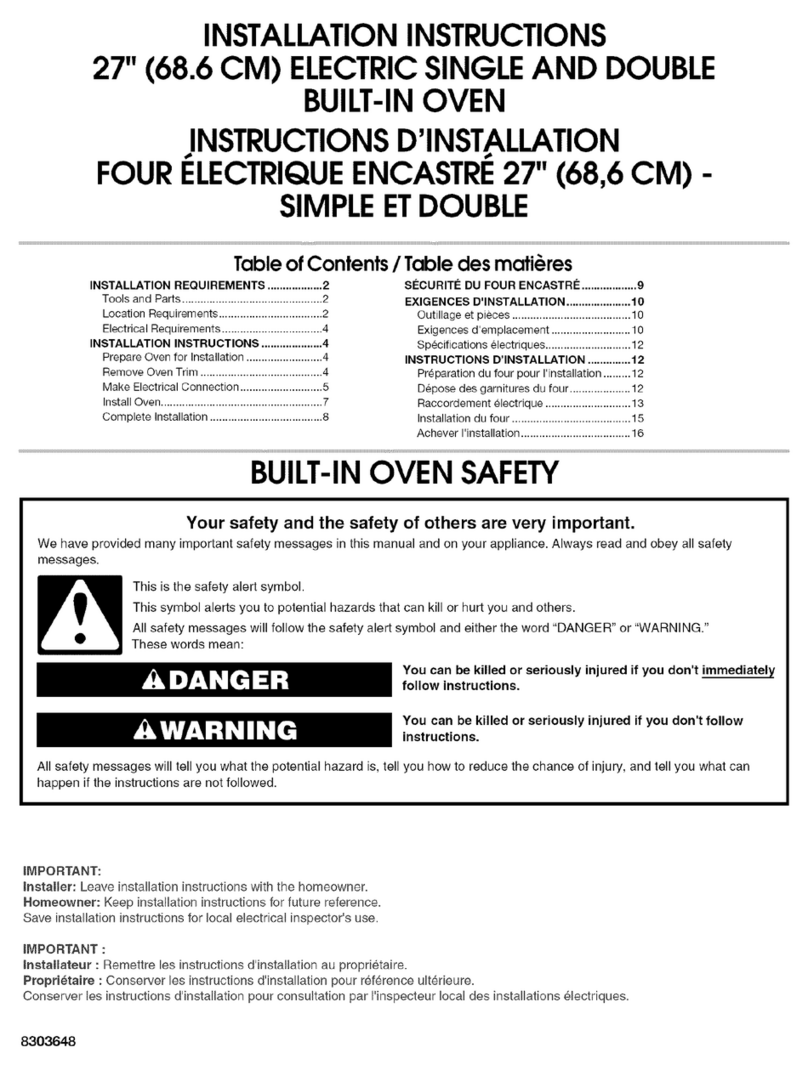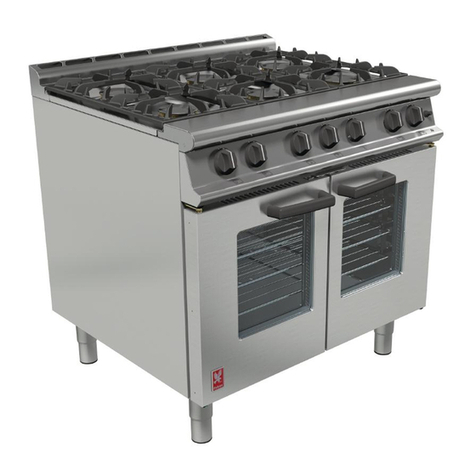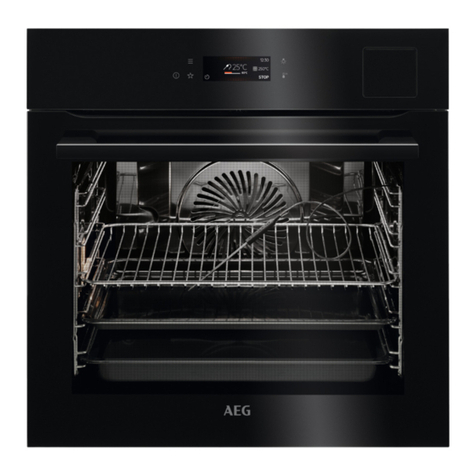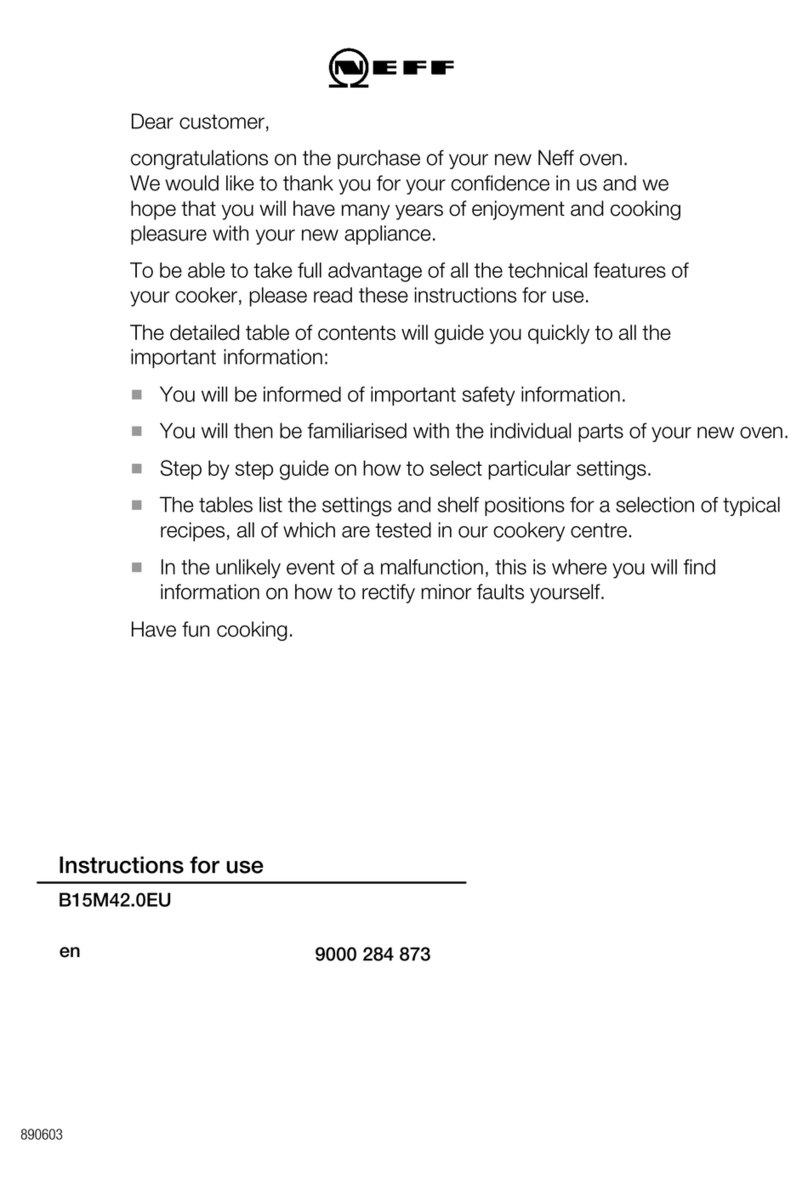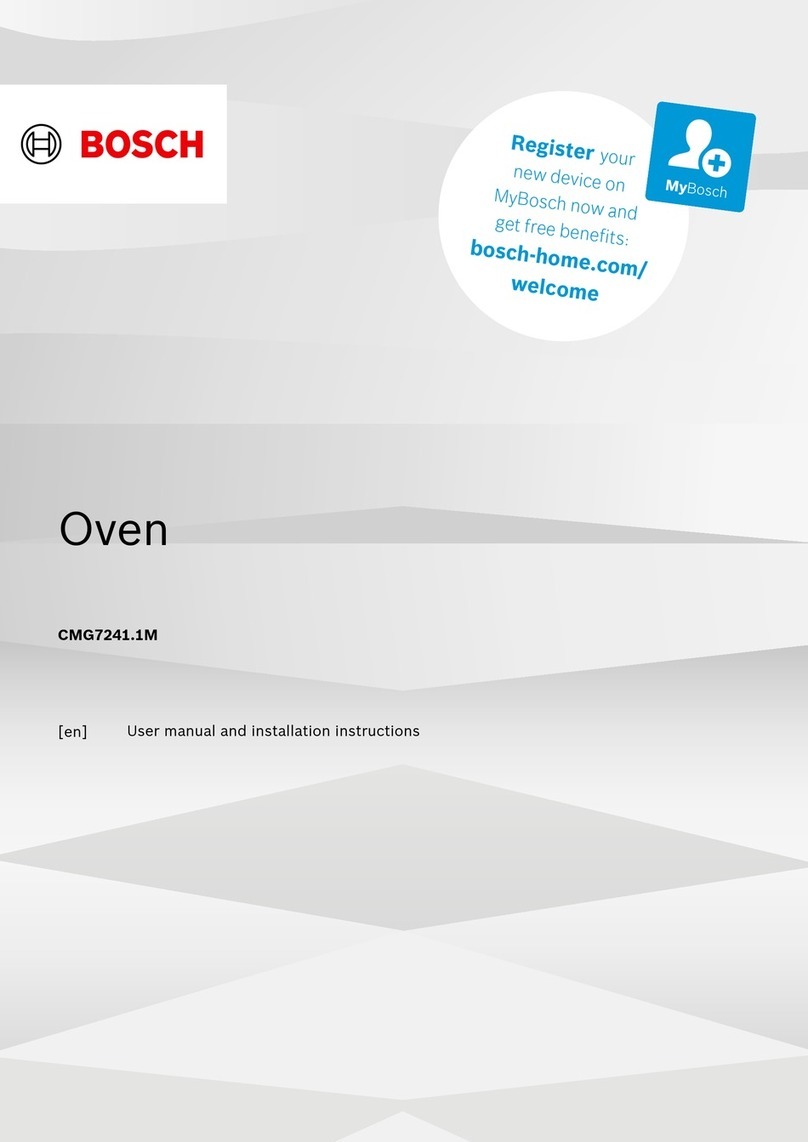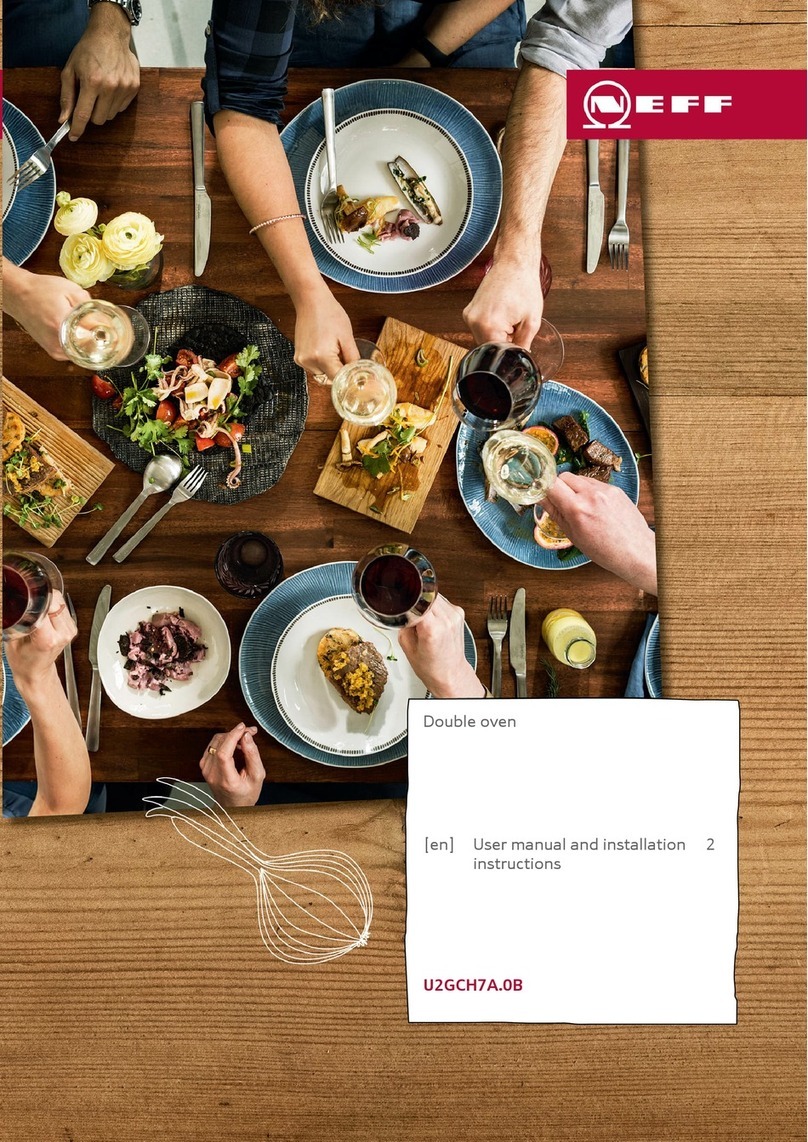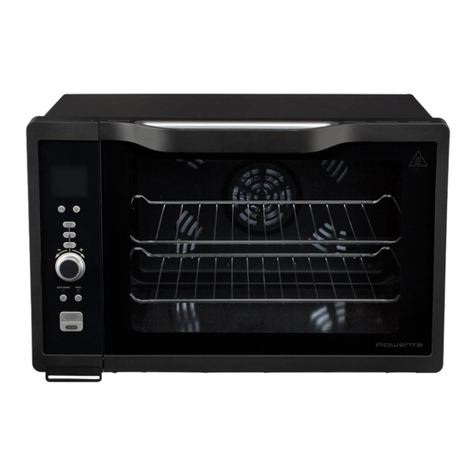Sub-Zero Wolf M Series User manual

M Series
M Series
General Information
1-2
#824974 - Revision C - November, 2016
INTRODUCTION
This Technical Service Manual has been compiled to provide the most recent technical service information. This
information will enable the service technician to troubleshoot and diagnose malfunctions, perform necessary repairs
and return the appliance to proper operational condition.
The service technician should read the complete instructions contained in this service manual before initiating any
repairs on a Wolf Appliance.
For installation information see M Series Ovens Installation Guide available at http://www.subzero-wolf.com/trade-
resources/product-specifications.
For Use and Care information see M Series Ovens Use & Care Guide available at http://www.subzero-
wolf.com/trade-resources/product-specifications.
IMPORTANT SAFETY INFORMATION
Below are the Product Safety Labels used in this manu-
al. The "Signal Words" used are WARNING and
CAUTION.
Please note that these safety labels are placed in areas
where awareness of personal safety and product safety
should be taken and lists the precautions to be taken
when the signal word is observed.
This manual is designed to be used by Certified Service Personnel only. Wolf Appliance, Inc. assumes no
responsibility for any repairs made to Wolf appliances by anyone other than Certified Service Technicians.
INDICATES THAT HAZARDOUS OR UNSAFE
PRACTICES COULD RESULT IN SEVERE PERSON-
AL INJURY OR DEATH.
Indicates that hazardous or unsafe practices could
result in minor personal injury or product and/or
property damage
In addition, please pay attention to the signal word
“NOTE”, which highlights especially important informa-
tion within each section.
The information and images are the copyright property of Wolf Appliance, Inc., an affiliate of
Sub-Zero Group, Inc. Neither this manual nor any information or images contained herein may be copied or used in
whole or in part without the express written permission of Wolf Appliance, Inc., an affiliate of Sub-Zero Group, Inc. ©
Wolf Appliance, Inc., all rights reserved.
TECHNICAL ASSISTANCE
If you should have any questions regarding the appli-
ance and/or this manual, please contact:
Wolf Appliance, Inc.
ATTN: Service Department
P.O. Box 44988
Madison, WI 53744 - 4988
Customer Care
Phone #: (800) 332 - 9513
Facsimile #: (608) 441 - 5887
Technical Assistance
(For Technicians in Customer’s Homes Only)
Phone #: (800) 919 - 8324
Warranty Claims
Phone #: (800) 404 - 7820
Facsimile #: (608) 441 - 5886
Service Department e-mail Address:
customerservice@wolfappliance.com
Main Office Hours:
8:00 AM to 5:00 PM Central Time
Monday through Friday
(24/7 Phone Coverage)
https://appliancetechmanuals.com

General Information
M Series
M Series
1-3 #824974 - Revision C - November, 2016
WARRANTY INFORMATION
This page contains a summary of the Warranty supplied with every Domestic Wolf M Series Oven.
2 & 5 Year Warranty Summary:
2 Year Total Product Warranty, Parts and Labor.•
3-5 Limited Parts Only Warranty.•
Details:
Warranty applies to products installed in United States or Canada, for residential use only.•
Warranty begins at time of unit’s initial installation.•
Warranty does not cover Wolf Appliances installed in a demonstration kitchen, test kitchen, culinary school•
kitchen, or similar installations. (See Special Warranty below)
Warranty and service information collected by Wolf Appliance, Inc. is arranged and stored under unit serial num-•
ber and/or customer’s name. Wolf Appliance, Inc requests that you have model and serial number available
whenever contacting factory or parts distributor.
3-5 Year Limited Parts Only Warranty applies to the relay board, UIM board, Display board, mode selector•
board, slew selector board, control panel assembly, and all heating elements.
Special Warranty Summary
2 Year Total Product Warranty, Part and Labor.
Details:
This Warranty applies to products installed in United States or Canada, for use in a demonstration kitchen, test•
kitchen, culinary school kitchen, and similar installations that will help promote Wolf Appliance brand and its
products.
Warranty begins at time of unit’s initial installation.•
Warranty and Service information collected by Wolf Appliance, Inc. is arranged and stored under unit serial num-•
ber and/or customer’s name. Wolf Appliance, Inc. requests that you have model and serial number available
whenever contacting factory or parts distributor.
NOTE: “ICB” appliances carry no factory warranty. The product distributor or appliance dealer may offer their own
warranty.
Figure 1-2. The rating plate is located on the lower trim.
Figure 1-1. Typical Serial Tag Layout
RATING
PLATE
https://appliancetechmanuals.com

M Series
M Series
General Information
1-4
#824974 - Revision C - November, 2016
Refer to this key for an example of the model numbers.
Model: ICB SO 30 P M / S / PH
International Designation
Product Configuration
Size
Product Style
Finish
Handle Type
Product Configuration
SO = Single Oven
DO = Double Oven
Size
27 = 27 - inch wide unit
30 = 30 - inch wide unit
36 = 36 - inch wide unit
Product Style
PM = Professional M Series
TM = Transitional M Series
CM = Contemporary M Series
Finish
SClassic Stainless Steel
BBlack Glass
Handle Type
PH = Pro Handle
TH = Tubular Handle
• Three styles
Professional M Series
Transitional M Series
Contemporary M Series
• Dual VertiCross™ Convection
• Graphic User Interface with color touch screen
• Flush inset applications fit standard cabinetry
• Large Viewing Window
• Three Halogen Oven Lights
• Temperature Probe and Receptacle
• Six Level Rack Guide
• Two Full Extension Racks
• Hidden Bake Element
• Broil Element
• Bake Mode
• Convection Mode
• Broil Mode
• Roast Mode
• Convection Roast Mode
• Baking Stone Mode (Bake Stone Optional)
• Dehydrate Mode (Dehydrate Kit Optional)
• Proof Mode
• Warm Mode
• Gourmet Mode
• Self-Clean Mode
• Sabbath Mode
OVEN FEATURES
MODEL NUMBER KEY
https://appliancetechmanuals.com

General Information
M Series
M Series
1-5 #824974 - Revision C - November, 2016
M SERIES CONFIGURATIONS
27” Single Oven - Transitional
Model Number: SO27TM/S/TH
Description: Single Oven, 27”, Transitional M Series /
Stainless / Tubular Handle
Model Number: SO30TM/S/TH
Description: Single Oven, 30”, Transitional M Series /
Stainless / Tubular Handle
Transitional Ovens
30” Single Oven - Transitional
36” Single Oven - Transitional
Model Number: SO36TM/S/TH
Description: Single Oven, 36”, Transitional M Series /
Stainless / Tubular Handle
https://appliancetechmanuals.com

M Series
M Series
General Information
1-6
#824974 - Revision C - November, 2016
27” Double Oven - Transitional 30” Double Oven - Transitional
Model Number: DO27TM/S/TH
Description: Double Oven, 27”, Transitional M Series /
Stainless / Tubular Handles
Model Number: DO30TM/S/TH
Description: Double Oven, 30”, Transitional M Series /
Stainless / Tubular Handles
https://appliancetechmanuals.com

General Information
M Series
M Series
1-7 #824974 - Revision C - November, 2016
UPPER OVEN LOWER OVEN
30” Double Oven - Professional
Model Number: DO30PM/S/PH
Description: Double Oven, 30”, Professional M Series /
Stainless / Professional Handles
30” Single Oven - Professional
Model Number: SO30PM/S/PH
Description: Single Oven, 30”, Professional M Series /
Stainless / Professional Handle
Professional Ovens
https://appliancetechmanuals.com

M Series
M Series
General Information
1-8
#824974 - Revision C - November, 2016
30” Double Oven - Contemporary
Model Number: DO30CM/B
Description: Double Oven, 30”, Contemporary M
Series / Black Glass
30” Single Oven - Contemporary
Model Number: SO30CM/B
Description: Single Oven, 30”, Contemporary M Series
/ Black Glass
Contemporary Ovens - Black
https://appliancetechmanuals.com

General Information
M Series
M Series
1-9 #824974 - Revision C - November, 2016
30” Double Oven - Contemporary
Model Number: DO30CM/S
Description: Double Oven, 30”, Contemporary M
Series / Stainless Steel
30” Single Oven - Contemporary
Model Number: SO30CM/S
Description: Single Oven, 30”, Contemporary M Series
/ Stainless Steel
Contemporary Ovens - Stainless Steel
https://appliancetechmanuals.com

M Series Wall Oven
M Series Wall Oven
Electronics
2-2
#824974 - Revision C - November, 2016
ELECTRONICS
This section is divided into four parts. The General Oven Section lists the parameters the oven operates under
given the power supply the oven is connected to. The Components section gives details on the electronic require-
ments and programming of specific components. The Non-Cooking Modes section provides parameters on how the
non-cooking modes operate electronically. The Cooking Modes section provides the parameters of the cooking
stages of each cooking mode.
GENERAL OVEN
Detects incoming power to within 3 VAC and adjusts algorithms as appropriate. Incoming power is detected and•
set at the start of a cooking mode.
Operates in 50 Hertz (Hz) mode when input power is between 47 Hz and 55 Hz.•
Operates in 60 Hz mode when input power is between 55 Hz and 63 Hz.•
Reports a supply voltage failure for input frequencies below 47 Hz and above 63 Hz.•
Enters a reset state for input frequencies below 40 Hz and above 70 Hz.•
Operates in 240 Volts Alternating Current (VAC) mode when input power is between 224 VAC and 265 VAC.•
Operates in 208 VAC mode when input power is between 177 VAC and 224 VAC.•
Reports a brown out error when input power is between 140 VAC and 177 VAC.•
Operates in showroom mode when input power is between 100 VAC and 140 VAC.•
Reports a supply voltage failure for input power below 100 VAC and above 265 VAC if it is still operating.•
A single oven uses no more than 24 Amperes (Amps) at 240 VAC.•
A double oven uses no more than 44 Amps at 240 VAC.•
An oven cavity does not exceed 20 Amps in any configuration.•
Automatically enters a standby mode using less than .5 Watts unless disabled.•
COMPONENTS
Resistance Temperature Detector (RTD)
Input determines the cavity temperature.•
One per cavity•
Controls do not introduce more than 2% error into the RTD temperature readings.•
Controls report an open RTD failure above 3049 Ω (approximately 1100° Fahrenheit (F)).•
Controls report a shorted RTD failure below 825 Ω (approximately -50° F).•
Is a platinum resistance type device measuring 1000 Ω at 32° F.•
Maximum voltage is 12 Volts Direct Current (VDC) and the maximum current is 2 milliamperes (mA).•
Probe
Is available for use in each cavity or simultaneously in both cavities.•
Temperatures below 32° F and above 255° F are not displayed.•
Controls do not introduce more than 2% error into the temperature probe temperature readings.•
Does not provide a chassis ground connection to the control circuitry when inserted.•
Controls deem no Probe inserted above 400 kilo ohms (kΩ) (approximately 2° F).•
Controls report a shorted Probe below 1000 Ω (approximately 295° F).•
Door Lock
If position is not located within 45 seconds, the controls will make two more attempts. If a position is not located•
after that a fault is generated.
Switches operate on a class 2 circuit at 5 VDC.•
https://appliancetechmanuals.com

Electronics
M Series Wall Oven
M Series Wall Oven
2-3 #824974 - Revision C - November, 2016
Graphic Users Interface (GUI)
Allows for a single-point touch operation.•
Allows for a scroll or drag touch operation.•
Allows for perceived movement of lists for a throw or flick of a finger.•
Allows for user calibration of the touch sensor positioning.•
Pro Oven Model Knobs
The left knob of each pair is the mode selector switch, called the Mode Knob. It has a full 360° rotation with nine
detents. 0° is located at the top center of the knob.
The right knob of each pair is the temperature selector switch, called the Slew Knob. It is used to select a setting
from a range that is displayed on the touch screen. The slew knob:
Is self-centering to a vertical position (0°).•
Does not rotate past 45° from center in either direction.•
Has five unique settings according to rotation angle.•
Large step increase is from 40° to 45°.•
Small step increase is from 15° to 25°.•
Stop is from -15° to 15°.•
Small step decrease is from -15° to -25°.•
Large step decrease is from -40° to -45°.•
Relay Board Ambient Temperature Sensor
Is used to detect if the ambient temperature is above or below the relay board operational temperature limit. The•
controls detect a temperature issue on the relay board and generate a fault.
Is used to control the single/upper cooling fan speed.•
User Interface Module (UIM) Audible Notification
Uses a piezo beeper for audible notifications.•
Produces two basic tones consisting of a beep sound and a chime sound. The beep is a steady tone with con-•
stant amplitude. The chime has a tone that starts at full volume and decays to low volume before ceasing.
Frequency and duration definition of user interactions, error messages, preheat complete, and timer expirations•
by external USB interface.
Volume adjustment with six volume levels including mute.•
Frequency adjustment with three frequency levels.•
Does not initiate or discontinue a sound based on a change in the door switch status.•
Mode Detent Angle Selected Range
Off 0° 346° - 14°
Convection 28° 14° - 42°
Convection Roast 56° 42° - 70°
Warm 84° 70° - 98°
Gourmet 112° 98° - 126°
More 248° 126° - 262°
Roast 276° 262° - 290°
Broil 304° 290° - 318°
Bake 332° 318° - 346°
https://appliancetechmanuals.com

M Series Wall Oven
M Series Wall Oven
Electronics
2-4
#824974 - Revision C - November, 2016
UIM and Relay Board Status Indicators
The UIM and relay board have two visual status indicators. The red status indicator is always active when either
board has power. The green status indicator flashes when communications are operating and is off when communi-
cations cease. The status indicator on the UIM does not operate in standby mode. In standby mode the relay board
status indicator blinks approximately every two seconds.
7” Display - Transitional and Contemporary
Brightness is adjustable by the software and by the user from 0% to 100% in 5% increments.•
User setting of 0% is equivalent to 2% of the actual display brightness.•
Will not allow condensation on the display from opening of the oven door to be recognize as a key press and will•
not give any feedback.
7” Display - Professional
Is the same as the Contemporary and Transitional models•
Will not allow for mode selection through the GUI. Mode is only intended to be set though the mode knob.•
Cooling Fan
The fan speed at low, medium, and high is determined by the relay board software.•
The current relay board software version is 3.0.4.0.•
Operated by triac and detected during operation by voltage sense.•
Is settable for high, medium and low speeds by a stored setting in memory.•
Speed range is settable from 0 to 15.•
Has a separate set of parameters for when the oven is cooking and for when the oven is off.•
Single oven at 240 VAC and 60 Hz: Low speed is 9; medium speed is 12; and high speed is 15.•
Upper and lower oven at 240 VAC and 60 Hz: Low speed is 9; medium speed is 13; and high speed is 15.•
Single oven at 230 VAC and 50 Hz: Low speed is 10; medium speed is 12; and high speed is 15.•
Upper and lower oven at 230 VAC and 50 Hz: Low speed is 9; medium speed is 13; and high speed is 15.•
Single oven at 208 VAC and 60 Hz: Low speed is 12; medium speed is 12; and high speed is 15.•
Upper and lower oven at 208 VAC and 60 Hz: Low speed is 13; medium speed is 15; and high speed is 15.•
On single oven and upper oven speed is controlled by RTD and relay board temperatures and the active mode.•
Each temperature sensor (in all ovens) will request a certain fan speed related to temperature.•
Runs at maximum speed when an error is detected on that temperature sensor.•
Runs at maximum speed when Dehydrate mode is active.•
Runs the highest requested speed from any temperature sensor.•
Runs while door is open on single and upper oven.•
Stops running when lower oven door is open.•
Speed on lower oven is controlled by the lower RTD and the active lower mode.•
Upper and lower oven will run at the highest requested speed of the three temperature sensors when the upper•
oven RTD is greater than 550° F.
Will resume independent operation when the RTD sensor of the upper oven falls below 545° F.•
Configuration memory has a Low Fan On temperature, a Low Fan Off temperature, a Medium Fan On tempera-•
ture, a Medium Fan Off temperature, a High Fan On temperature, and a High Fan Off temperature for each sen-
sor in the system.
Temperature settings are enforced by the UIM software and have this relationship between temperatures:•
Low Fan On < Medium Fan On < High Fan On•
Low Fan Off < Medium Fan Off < High Fan Off•
Low Fan Off < Low Fan On•
Medium Fan Off < Medium Fan On•
High Fan Off < High Fan On•
https://appliancetechmanuals.com

Electronics
M Series Wall Oven
M Series Wall Oven
2-5 #824974 - Revision C - November, 2016
Cooling Fan Temperature Charts
Kitchen Timer
Consists of two independent timers for each model•
Is accessible at any time during any oven operation, excluding priority 1 faults.•
Program from 1 minute to 12 hours in one minute increments.•
End of timer sounds the beeper set at the user specified volume, and frequency.•
Cancel at any time through the GUI.•
Oven Lights
Will fade on and off (soft start).•
Will function when the oven is not in a cooking mode.•
Toggle on and off with the Oven Light key on the GUI.•
Turn on when the oven door is open.•
Return to the previous state after the door is closed, unless toggled by Oven Light key while the door was open.•
Retain the same status as when Sabbath mode was activated.•
Will turn off when entering Dehydrate mode and prevent the light from turning on when opening the door,•
although the light can still be operated using the Oven Light key.
Convection Fans
The fan speed is determined by the relay board software.•
The current relay board software version is 3.0.4.0.•
Turn off when the door is open, except during Dehydrate Mode and Sabbath Mode.•
Have four speed settings, one for 240 VAC/60 Hz operation, one for 208 VAC/60 Hz operation, one for•
240 VAC/50 Hz operation, and one for 208 VAC/50 Hz operation
Operate according to settings defined for the current cooking stage regardless of the call for heat status.•
Speed at 240 VAC 60 Hz is 11•
Speed at 240 VAC 50 Hz is 12•
Speed at 208 VAC 60 Hz is 15•
Speed at 208 VAC 50 Hz is 15•
Oven On Low Fan On Low Fan Off Med. Fan On Med. Fan Off Hi Fan On Hi Fan Off
Upper Oven
RTD 250° F 220° F 375° F 325° F 535° F 485° F
Relay Board 120° F 115° F 140° F 135° F 154° F 145° F
Lower Oven
RTD 250° F 220° F 375° F 325° F 535° F 485° F
Oven Off Low Fan On Low Fan Off Med. Fan On Med. Fan Off Hi Fan On Hi Fan Off
Upper Oven
RTD 250° F 220° F 375° F 325° F 535° F 485° F
Relay Board 130° F 120° F 145° F 140° F 154° F 145° F
Lower Oven
RTD 250° F 220° F 375° F 325° F 535° F 485° F
https://appliancetechmanuals.com

M Series Wall Oven
M Series Wall Oven
Electronics
2-6
#824974 - Revision C - November, 2016
Temperature Probe
Reading is displayed when the temperature probe is inserted and the probe setpoint is set.•
Has the option for the user to enter a set temperature.•
Activates a tone when the temperature probe reaches set temperature, but does not affect the cooking mode.•
Heating Element - Bake
Operates according to settings defined for the current cooking stage when the door is closed.•
Continues normal operation for the first 20 seconds after the door is opened.•
Does not operate beyond 20 seconds after the door has been opened, until the door is closed.•
Closing the door resets the 20 second open door timer.•
Heating Element - Broil
Operates according to the settings defined for the current cooking stage when the door is closed.•
Continues normal operation for the first 20 seconds after the door is opened.•
Does not operate beyond 20 seconds after the door has been opened, until the door is closed.•
Closing the door resets the 20 second open door timer.•
Heating Element - Convection
Operates according to settings defined for the current cooking stage.•
Will not operate without the convection fan running.•
Shuts off when the door is open, because the convection fan stops when the door is open.•
Non-Cooking Modes
Data Logging
The UIM logs all of the following data for each cavity once per second during a cooking operation lasting up to 12
hours. The data is accessible through the USB interface:
What mode•
AC supply voltage•
Cavity set temperature•
Cavity actual temperature•
Cavity relay request status•
Temperature probe actual temperature•
Relay board ambient temperature•
Time stamp (per data logged)•
Temperatures are logged in 1°F increments.•
UIM logs the input voltage setting used for each oven operation.•
UIM logs at least the last five oven operations per cavity.•
UIM writes the logs to non-volatile memory at least once every 10 minutes. Logs less than 10 minutes old may•
be stored in volatile memory. The UIM has the ability to write logs to an external USB device.
https://appliancetechmanuals.com

Electronics
M Series Wall Oven
M Series Wall Oven
2-7 #824974 - Revision C - November, 2016
Statistics
The oven records and reports the following statistics for each cavity. The data is accessible through the
USB interface:
Operation time (from start of preheat to mode cancel)•
Last 5 functions•
Mode•
Operation time•
Last set temperature•
Preheat duration•
Overshoot•
Number of call for heat cycle•
Duration of call for heat cycles•
Number of door openings•
Duration of door openings•
The oven will record and report the following statistics for the entire system through Diagnostics:
Number of power on cycles•
Operation time•
Standby time•
Last 20 errors•
Diagnostic Capability and Compatibility
On power up runs Power on Self Test (POST) that includes a self check of the overall health of the system.•
Fault codes are organized in a priority-based scheme which orders different behavior based on the priority of the•
fault.
Logs faults into memory for later inspection.•
Logs all detected faults regardless of priority.•
Faults can be canceled by the user or self-correcting.•
Multiple instances of the same fault updates the time stamp to show the latest occurrence.•
Text phrases are displayed to describe the fault.•
The initial display of a fault to the user is accompanied by the fault tone.•
An active fault is a fault that is currently being displayed to the user.•
Only one fault can be active at any time for each cavity. Additional faults are debounced and logged while•
another fault is active.
Power On Self Test (POST)
Tests that are performed during POST:
Verify all devices connected to the main system bus are communicating.•
GUI system communications and status•
Peripheral memory device test.•
Establish and verify connection of loads and wiring as applicable.•
Verify that all critical oven and door sensors are operating.•
Retrieve software versions of all programmed devices.•
Verify all configuration data is valid.•
https://appliancetechmanuals.com

M Series Wall Oven
M Series Wall Oven
Electronics
2-8
#824974 - Revision C - November, 2016
Initial Power Up
The initial power up sequence is only performed the first time the unit is turned on. The initial power up sequence is
performed regardless of the voltage detected at power up. The following tests are performed at initial power up:
1. POST
2. Detect input voltage and input frequency.
3. Detect single/double oven status.
4. If detecting 60 Hz input, then set to default US units and English language.
5. If detecting 50 Hz input, then set to default metric units and prompt for language selection.
6. Display set Time Of Day (TOD) screen for 5 minutes then go to Idle mode.
Showroom Power Up
The showroom power up sequence is performed when the unit is turned on in showroom mode:
1. Detect input voltage and input frequency.
2. Detect single/double oven status.
3. Display set TOD screen for 5 minutes then go to Idle mode.
Sabbath Power Up
The Sabbath power up sequence is performed when the unit is turned on in Sabbath mode. The display shall remain
blank during the Sabbath power up sequence:
1. POST
2. Detect input voltage and input frequency.
3. Detect single/double oven status.
Normal Power Up
The normal power up sequence is performed at all other power ups:
1. POST
2. Detect input voltage and input frequency.
3. Detect single/double oven status.
4. Display set TOD screen for 5 minutes then go to Idle mode.
Power Down Mode
This mode is activated when the power supply detects a drop on the incoming power. During this time the system
saves the TOD and writes out to flash memory any statistics buffered in RAM. The controls will conserve power to
keep the minimal system alive during this mode. The display and oven elements do not operate during this mode.
The safety systems are not compromised while in this mode. If the incoming power is not restored after the system
completes the shutdown procedure, the controls will enter a reset state. If the incoming power is restored before the
system completes the shutdown procedure, the controls will resume the previous mode.
Idle Mode
This mode is the default mode when another mode is not active. The purpose of idle mode is to display the TOD
clock and wait for input to enter another mode. Oven lights, cooling fan and timers are active during this mode.
https://appliancetechmanuals.com

Electronics
M Series Wall Oven
M Series Wall Oven
2-9 #824974 - Revision C - November, 2016
Standby Mode
This mode is activated when the controls have been in the idle mode for 5 minutes without a touch event, an active
timer, an active fault or a non-cooking event (cooling fan on, door movement). In this mode the controls shall comply
with the standby power requirements. The standby mode can be enabled or disabled in Settings. The safety sys-
tems are not compromised in this mode. Exit this mode by a touch or a knob event.
User Settings
Users can adjust the following settings through the Settings menu:
Language (English/Spanish/French/Italian/German/Dutch)•
Time of day (HH:MM) (am/pm)•
Time Format (12 hr/24 hr)•
Clock Style (Analog/Digital)•
0.5W standby power mode (On/Off)•
Display Brightness (0 - 100%) – does not necessarily correspond to actual display minimum and maximum•
Units (°F/°C) also sets weight units (lb/kg) and distance units (in/mm)•
Temperature Offset (± 35° F)•
Touch Screen Calibration•
Sound Volume (Mute/1/2/3/4/5)•
Sound Frequency (Low/Medium/High)•
Showroom mode (On/Off)•
Sabbath mode (On/Off)•
GUI operation for Transitional, Contemporary and Professional models from standby mode:
1. Touch the GUI and the main screen is displayed.
2. Touch Settings and the Settings menu is displayed.
A. Language:
i. Scroll to LANGUAGE,then touch LANGUAGE.
ii. Scroll to desired language (English) then touch the language.
iii. Touch SET.
iv. System shuts down and reboots in new language.
B. Time of day (TOD) and Time Format:
i. Scroll to TIME, then touch TIME.
ii. Scroll to 12 HOUR MODE or 24 HOUR MODE, then touch the desired mode.
iii. GUI displays SET CLOCK screen. Set the correct time.
iv. Touch SET. GUI displays “Settings Saved,” then the Settings menu.
C. Clock Style:
i. Scroll to CLOCK, then touch CLOCK.
ii. Scroll to ANALOG or DIGITAL, then touch ANALOG or DIGITAL.
iii. Touch SET. GUI displays “Settings Saved,” then the Settings menu.
D. Standby Power:
i. Scroll to STANDBY POWER, then touch STANDBY POWER.
ii. Scroll to ON or OFF, then touch ON or OFF.
iii. Touch SET. GUI displays “Settings Saved,” then the Settings menu.
E. Brightness:
i. Scroll to BRIGHTNESS, then touch BRIGHTNESS.
ii. Scroll to level of desired brightness from 0% to 100% in 5% increments, then touch desire percentage.
ii. Touch SET. GUI displays “Settings Saved,” then the Settings menu.
F. Units:
i. Scroll to UNITS, then touch UNITS.
ii. Scroll to °F/IMPERIAL or °C/METRIC, then touch °F/IMPERIAL or °C/METRIC.
iii. Touch SET. GUI displays “Settings Saved,” then the Settings menu.
(continued)
https://appliancetechmanuals.com

M Series Wall Oven
M Series Wall Oven
Electronics
2-10
#824974 - Revision C - November, 2016
G. Temperature Offset
i. Scroll to TEMPERATURE OFFSET, then touch TEMPERATURE OFFSET.
ii. Scroll to desired temperature offset. Negative numbers cause the oven to run at a cooler temperature,
and positive numbers cause the oven to run at a hotter temperature. On double ovens temperature
offset changes both ovens. Touch the desired temperature offset.
iii. Touch SET. GUI displays “Settings Saved,” then the Settings menu.
H. Touch Screen Calibration:
i. Scroll to CALIBRATION, then touch CALIBRATION.
ii. Display states “Touch dots to calibrate screen.” Touch the first white dot in the upper left corner.
iii. Next dot to touch appears in the lower left corner, then lower right corner, upper right corner and finally
the center.
iv. After center white dot is touched GUI displays “Calibration complete,” then the Settings menu.
I. Sound Volume and Frequency:
i. Scroll to SOUND, then touch SOUND.
ii. GUI displays volume settings on the left and frequency settings on the right. Scroll to desired volume
and/or frequency setting and touch the desired setting.
iii. Touch SET. GUI displays “Settings Saved,” then the Settings menu.
Diagnostic Mode
Provides access to the oven status information and self-test suite. See Section 4 - Troubleshooting for information
on how to enter Diagnostic mode. The self-test suite consists of the following items:
Displays inputs on the Control tab and Knob tab.•
Toggles outputs on the Control tab.•
Displays fault log on the Faults tab.•
Has individual component tests on the Control tab•
Has automatic tests through the Self Test button.•
Adjusts display graphics position through the Reposition Screen button.•
Showroom Mode
Is entered when the input voltage at power up is less than 140 VAC or through the Settings menu.•
Is restored after a power interruption only when the mode is entered through the Settings menu.•
Is exited only through the Settings menu and when voltage is above 177 VAC.•
Returns to the default settings from the initial power up when exited.•
Allows the GUI to be fully functional except for Diagnostics.•
Simulates the cavity temperatures and preheat temperature during cooking modes.•
Uses an accelerated preheat time.•
Operates the cooling fans according to actual temperature sensor readings and not simulated temperatures.•
Disables heating elements and convection fans.•
Does not log or display Priority 2 and Priority 3 errors.•
Disables all other logging.•
Does not count cavity and cooking mode statistics.•
Keeps system statistics.•
GUI operation for transitional, contemporary and professional models from standby mode:
1. Touch the GUI and the main screen is displayed.
2. Touch Settings and the Settings menu is displayed.
3. Scroll to SHOWROOM, then touch SHOWROOM.
4. Scroll to ON or OFF, then touch ON or OFF.
5. Touch SET. GUI displays “Settings Saved,” then the Settings menu.
https://appliancetechmanuals.com

Electronics
M Series Wall Oven
M Series Wall Oven
2-11 #824974 - Revision C - November, 2016
Cooking Modes
General Cooking Mode Operation
Preheat stages are not active after the cavity reaches set temperature, even if the set temperature is changed•
without canceling the mode.
All element and fan operation is specified by factory settings.•
Each cavity has a timer to cancel a cooking mode that has been continuously active for 12 hours.•
The 12 hour cooking limit will be disabled in Sabbath and Dehydrate modes.•
The 12 hour cooking limit will not be initiated until after the expiration of a delayed start timer.•
Opening the cavity door during an active cooking mode will reset the 12 hour timer.•
Adjusting the cooking mode will reset the 12 hour timer.•
Adjusting the temperature will reset the 12 hour timer.•
A cooking mode can be cancelled by the “OFF” key or knob, a fault detection, power down mode, expiration of•
timed cook, or the expiration of the 12 hour timer.
A cooking mode can not be started when the oven door is locked or Motorized Door Lock (MDL) has an error.•
Delayed Start and Timed Cook Modes
Are set while programing a cooking mode. The cooking mode can be delayed up to 24 hours, and have a dura-•
tion of up to 11 hours and 59 minutes.
Preheat stages and preheat notifications are skipped at the expiration of the delayed start timer.•
The cook timer begins immediately if a delayed start has not been set.•
If a delayed start has been set, the cook timer begins at the expiration of the delayed start timer.•
At the expiration of the cook timer, the timer complete tone is activated and the cooking mode is canceled.•
GUI operation for Transitional, Contemporary and Professional models from standby mode:
1. For Professional models, turn knob to desired mode
For Transitional and Contemporary models, touch the GUI and the main menu will be displayed.
a. Touch QUICK START and the cooking mode screen will be displayed.
b. Scroll to desired cooking mode, then touch it.
2. Touch TIMED COOK on the GUI to the right of the TOD
3. TIMED COOK menu is displayed. Scroll time to amount of cook time desired - up to 11 hours and 59 minutes.
4. Touch SET, and the STOP TIME menu is displayed. The time shown is for a zero minute delay start - the
cook time + 0 minutes. A STOP TIME can’t be set prior to this time. Scroll to the desired STOP TIME.
5. Touch SET. GUI displays “Settings Saved,” then the main display. The main display shows the mode, tempera-
ture, DURATION (cook time), STOP TIME, and states “Timed Cook set, oven to start at XX:YY.” See Figure 2-1.
6. Touch LIGHT to turn the light on.
Figure 2.1 Timed Cook and Delay Start Set
https://appliancetechmanuals.com

M Series Wall Oven
M Series Wall Oven
Electronics
2-12
#824974 - Revision C - November, 2016
Sabbath Mode
Enters a Sabbath mode standby, allowing mode, temperature, timed cook, and the light to be set.•
Touching the “Star K” symbol in the upper right corner of the GUI moves the unit from standby into Sabbath.•
Sabbath mode standby will only access Bake, Roast, Warming, and Proof modes.•
In order to activate Sabbath mode, a double oven has to have one cavity in an allowed cooking mode and the•
other cavity off or both cavities in allowed cooking modes.
The oven light has to be set in the Sabbath mode standby.•
Allows timed cooking, but no audible notification occurs at the completion of timed cooking.•
Timed cooking must be turned on prior to activating Sabbath Mode.•
Will cancel an active temperature probe, but will not cancel the cooking mode.•
Will not change the state of the oven light when the oven door is opened.•
Disables audible notifications.•
Changes the 20 second door open timer to a random value between 16 and 32 seconds each time the door is•
opened.
Allows temperature changes for Holidays. A new set temperature will change after a random delay of between•
16 and 32 seconds.
Restores Sabbath mode with any active cooking modes, set temperatures, and oven lights in the event of a•
power interruption.
Disables the 12 hour maximum oven on timer.•
Exits to the idle state when all of the active cooking modes are canceled with the oven off key or knob.•
GUI operation for Transitional, Contemporary and Professional models to enter Sabbath standby from standby
mode:
1. Touch the GUI and the main screen is displayed.
2. Touch Settings and the Settings menu is displayed.
3. Scroll to SABBATH, then touch SABBATH.
4. Scroll to ON or OFF, then touch ON or OFF.
5. Touch SET. GUI displays “Settings Saved,” then Settings menu.
GUI operation for Transitional, Contemporary and Professional models to activate Sabbath from Sabbath standby:
1. Set cooking mode, timed baked, delayed start and light as desired.
2. Touch “Star K” symbol in the upper right hand corner of GUI.
GUI operation for Transitional and Contemporary models to adjust temperature in Sabbath mode:
Touch the plus or minus key to adjust temperature 25°. There is no tone or visible change to confirm the tempera-
ture has been changed.
GUI operation for Professional model to adjust temperature in Sabbath:
Turn slew knob as far as possible in the plus or minus direction then release the slew knob. Will adjust the tempera-
ture 25°. There is no tone or visible change to confirm the temperature has been changed.
Gourmet Mode
Gourmet mode guides the user through cooking common foods. Based on the users selections, the oven will select
the most appropriate mode. Some modes will require the user to monitor the doneness of the food, while in other
modes the oven will alert the user when the food is done.
https://appliancetechmanuals.com
This manual suits for next models
11
Table of contents
Other Sub-Zero Oven manuals

